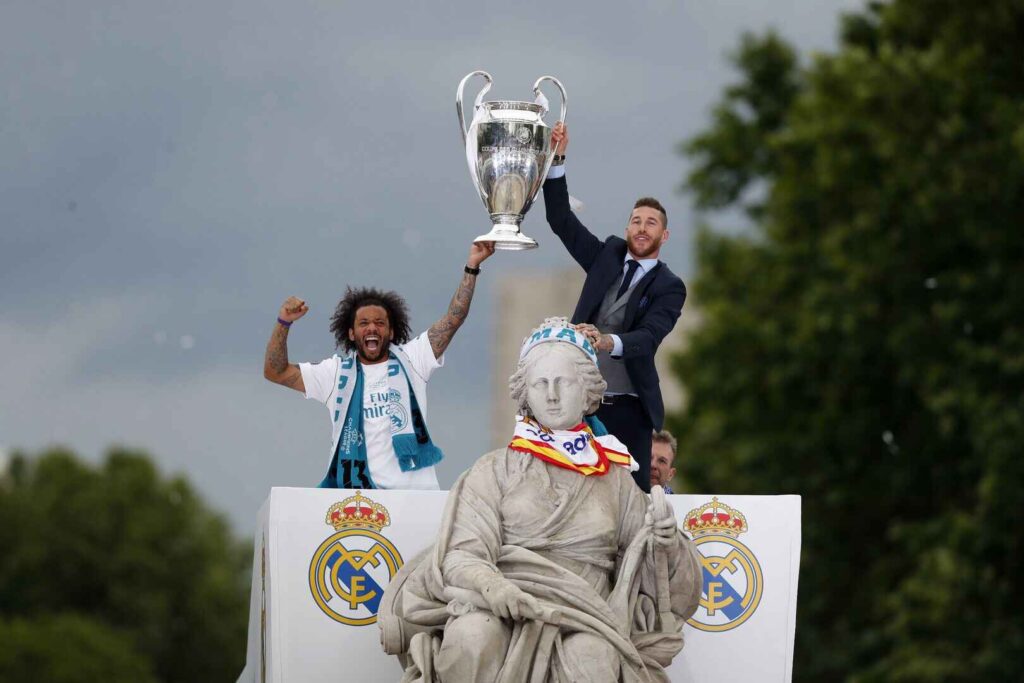If you’re a Real Madrid fan, or just love football, you’ve probably seen those epic scenes of celebration at the Cibeles fountain after Real Madrid win a big trophy.
But have you ever wondered why Real Madrid always gather there? Why does this particular place, the Fuente de Cibeles, hold such a special meaning for the club and its fans?
Let’s dive into this iconic tradition, starting with the history behind it and what makes it so important to Los Blancos.
The Origins of Celebrating at Cibeles
Real Madrid’s celebrations at the Cibeles fountain didn’t just happen out of nowhere. In fact, it wasn’t even Real Madrid who started the tradition!
Back in 1962, Atlético Madrid fans were the first to gather at the Fuente de Cibeles after their team won the European Cup Winners’ Cup by beating Fiorentina.
But given its central location in Madrid, it wasn’t long before Real Madrid fans caught on. The fountain became a common spot for celebrating victories, and soon, it became more associated with Real Madrid’s success.
During the late 1980s, when Real Madrid dominated La Liga, winning it five times in a row between 1986 and 1990, Cibeles became firmly linked to Los Blancos. It became their go-to spot to celebrate big wins.
Atlético Madrid, after being overshadowed by Real Madrid’s success, shifted their celebrations to another fountain, the nearby Fuente de Neptuno.
Today, the rivalry continues with Atlético fans celebrating at Neptuno while Real Madrid fans claim Cibeles as their own.
Why Cibeles for Real Madrid?
The Fuente de Cibeles isn’t just any fountain. It’s located right in the heart of Madrid at Plaza de Cibeles, and the statue it features has deep historical roots.
It depicts Cybele, a Phrygian goddess of earth and fertility, riding a chariot pulled by two lions. The fountain itself dates back to the 1700s, long before Real Madrid or Atlético Madrid even existed.
It wasn’t moved to its current location until 1895, but ever since then, it’s become one of Madrid’s most recognizable landmarks.
So, when Real Madrid fans wanted a place to gather after victories, Cibeles—right in the city’s center—was the perfect spot.
The Tradition of Celebrating Wins
After Real Madrid secures a major trophy, the celebrations at Cibeles are some of the most iconic scenes in football.
Players and fans gather together, and the captain of the team always plays a key role in the celebration.
For example, after winning the 2023-24 Champions League at Wembley, Real Madrid returned to Madrid, and familiar scenes unfolded at the Cibeles fountain.
Captain Nacho Fernandez draped the Real Madrid flag over the statue of Cybele and lifted the trophy for the crowd to see.
These moments are unforgettable for Madridistas as they represent the joy of another successful season.
The Role of the Captain

One of the most important parts of the Cibeles celebration is when the captain of the team places the Real Madrid scarf or flag on the statue.
It’s a symbolic gesture, showing the connection between the team, the fans, and the city itself.
Sergio Ramos, a former Real Madrid captain who led the team to numerous trophies, famously talked about his love for the Cibeles fountain.
Ramos once said, “It’s a true platonic love… Spending a moment with Cibeles is like when you see your mother again after going two or three months without seeing her.”
That deep emotional connection with the fountain is something every Real Madrid captain feels. The gesture of placing the flag on the statue is one of the highest honors for a player at the club.
Cibeles and Its Meaning Beyond Football
Cibeles isn’t just a spot for Real Madrid’s celebrations. It holds a special place in Spanish football history as well. During the 1986 World Cup, Real Madrid’s Emilio Butragueño scored four goals in Spain’s memorable win over Denmark.
This incredible performance caused Madrid fans to gather at Cibeles to celebrate, even though it was a national team victory.
This mix of Real Madrid’s influence on the Spanish national team and the celebration at Cibeles shows how intertwined the club is with football culture in Spain.
It’s not just about the trophies, but also about the moments of national pride and footballing excellence.
Real Madrid’s Champions League Dominance
Of course, Cibeles has seen plenty of action over the years, thanks to Real Madrid’s incredible success in the Champions League.
They’ve won the European Cup a record 15 times, which is more than twice as many as their closest rivals, AC Milan, who have seven titles.
Even when Real Madrid isn’t at their best, they have a knack for finding a way to win. Take the 2023-24 Champions League final, for instance. Borussia Dortmund may have been the better team for most of the game, but Real Madrid did what they always do—they found a way to lift the trophy.
Dani Carvajal’s goal in the 74th minute, followed by Vinicius Junior’s strike nine minutes later, secured the win for Los Blancos.
The next day, as expected, the Real Madrid players and their fans gathered at Cibeles to celebrate once more.
The sight of the team lifting the biggest trophy in European club football in front of their supporters is one that Madridistas will never forget.
A Tradition That Will Continue
The celebrations at Cibeles are not going anywhere. As long as Real Madrid continues to win trophies—and let’s be honest, they will—fans will keep gathering at the iconic fountain.
The tradition of celebrating there has become a crucial part of the club’s identity. It’s more than just a place; it’s a symbol of Real Madrid’s connection to the city, its fans, and its incredible history of success.
The Rivalry With Atlético Madrid
Even though Atlético Madrid started the tradition at Cibeles, the fountain is now synonymous with Real Madrid. After Atlético won the Copa del Rey in 1991, they made the switch to Fuente de Neptuno for their celebrations, a tradition that continues to this day.
Both fountains, Cibeles and Neptuno, represent the rivalry between the two Madrid giants. Each time either team wins a trophy, their fans take to the streets to celebrate at their designated fountain.
It’s a unique part of Madrid’s football culture, showing how two clubs can coexist and celebrate their own success in the same city.
Conclusion
The celebrations at Cibeles are an integral part of Real Madrid’s identity. What started as a tradition borrowed from Atlético Madrid has become something that defines Los Blancos.
The connection between the fountain, the fans, and the city is stronger than ever, and each time Real Madrid win a major trophy, you can be sure the fountain will be draped in white and echoing with the sound of Madridistas celebrating.
For Real Madrid fans, Cibeles isn’t just a fountain; it’s a place where dreams come true, trophies are lifted, and history is made.
So next time you see Real Madrid celebrating at Cibeles, you’ll know just how special that moment is—for the team, the fans, and the city of Madrid.



